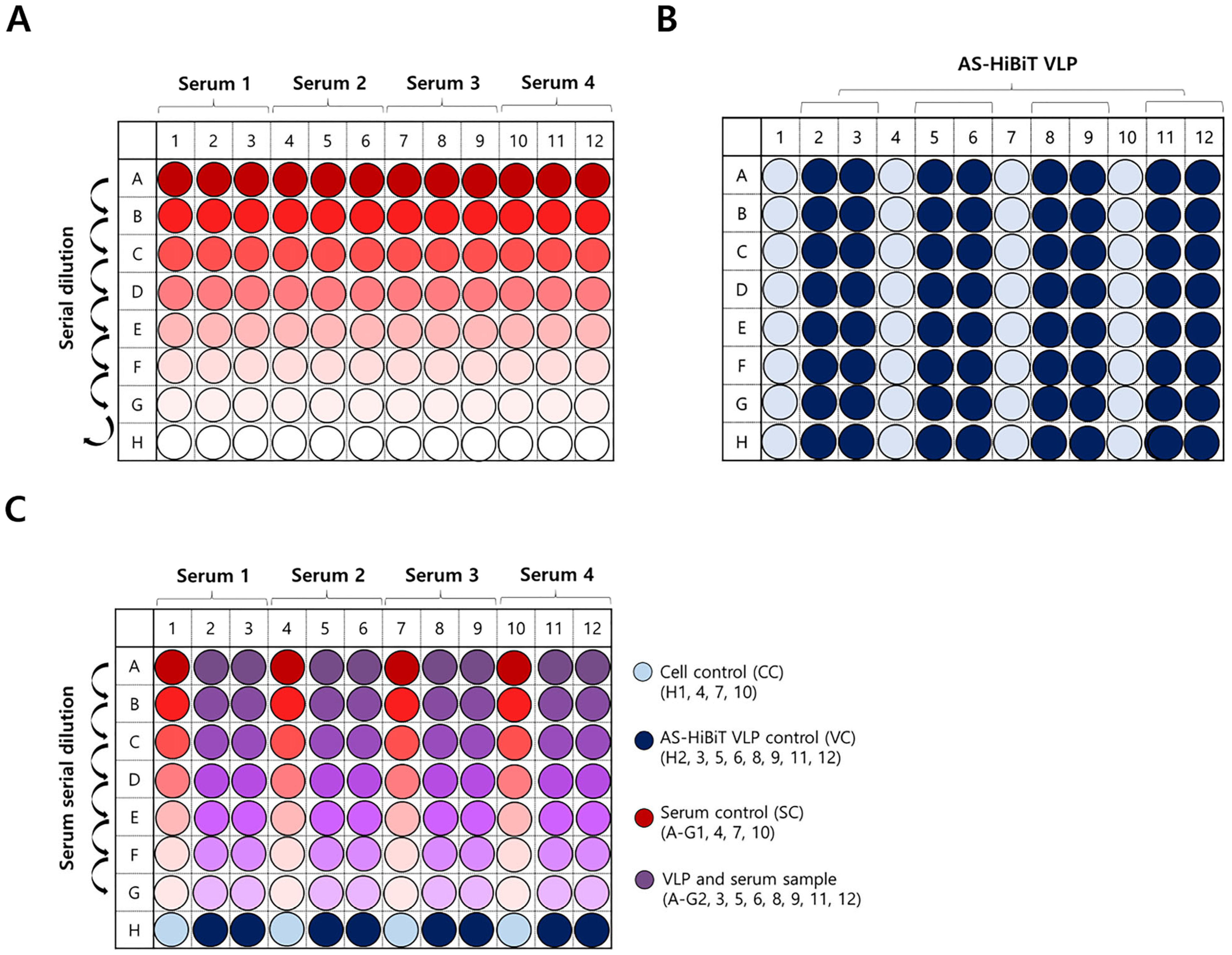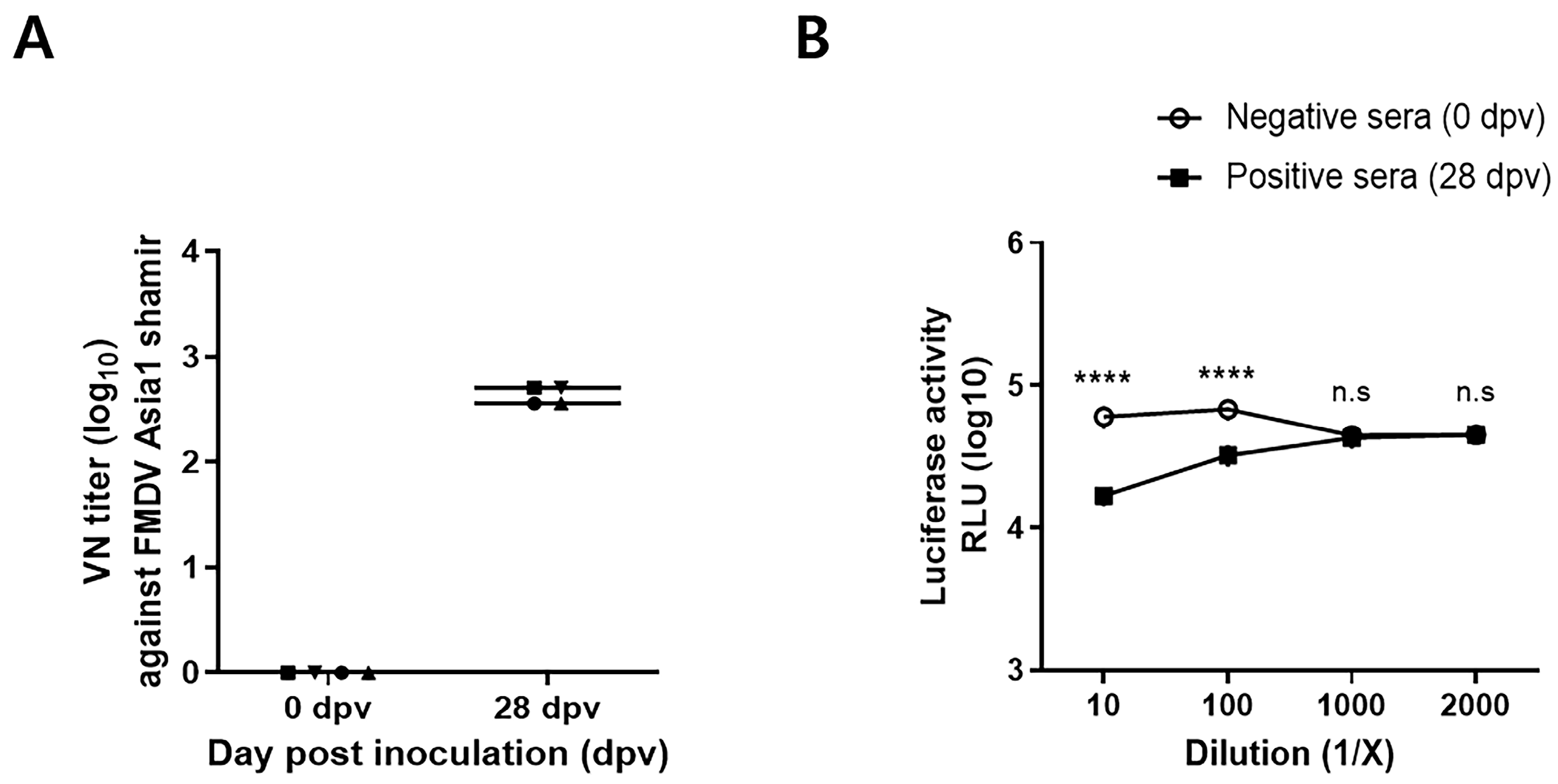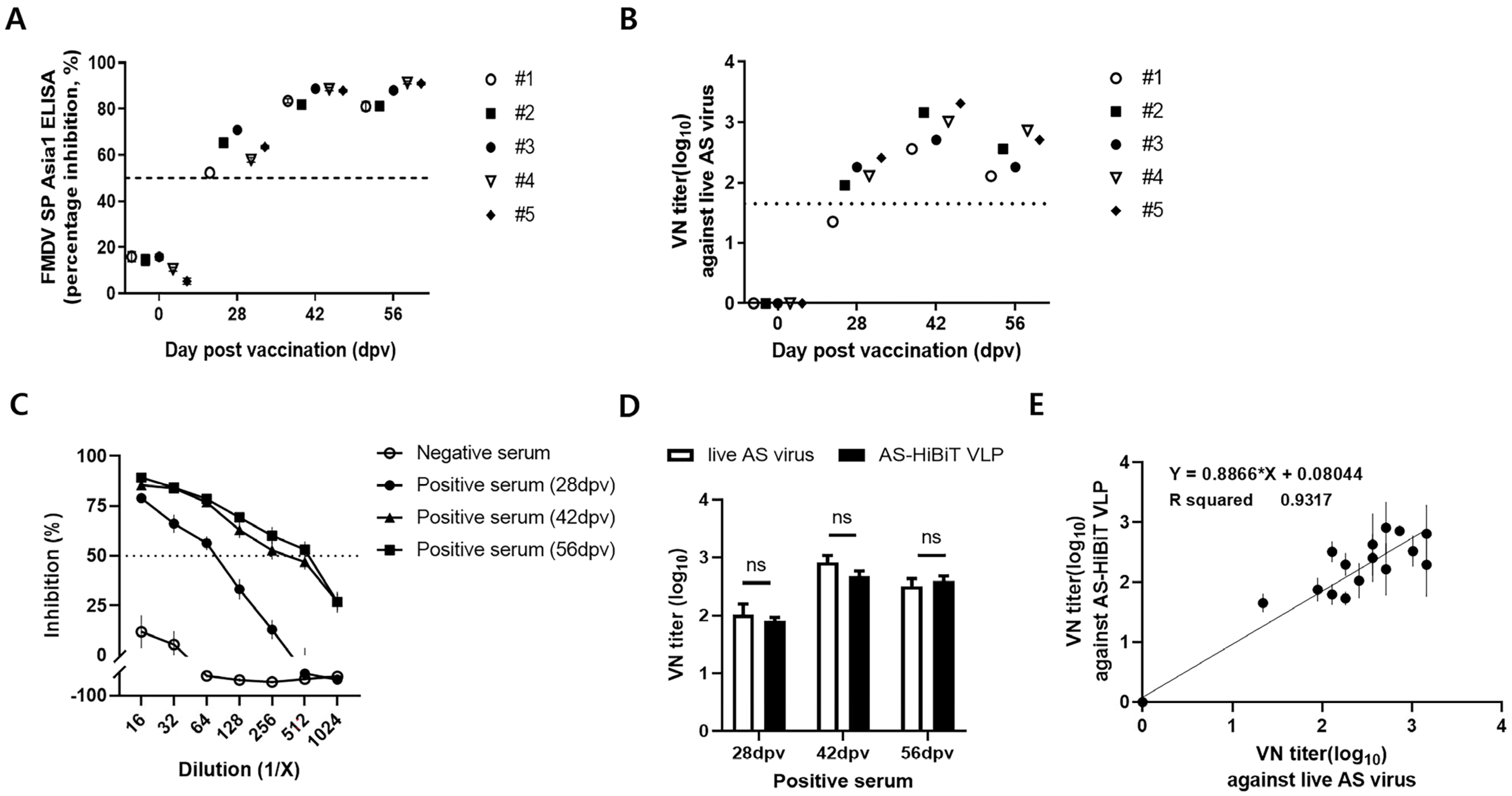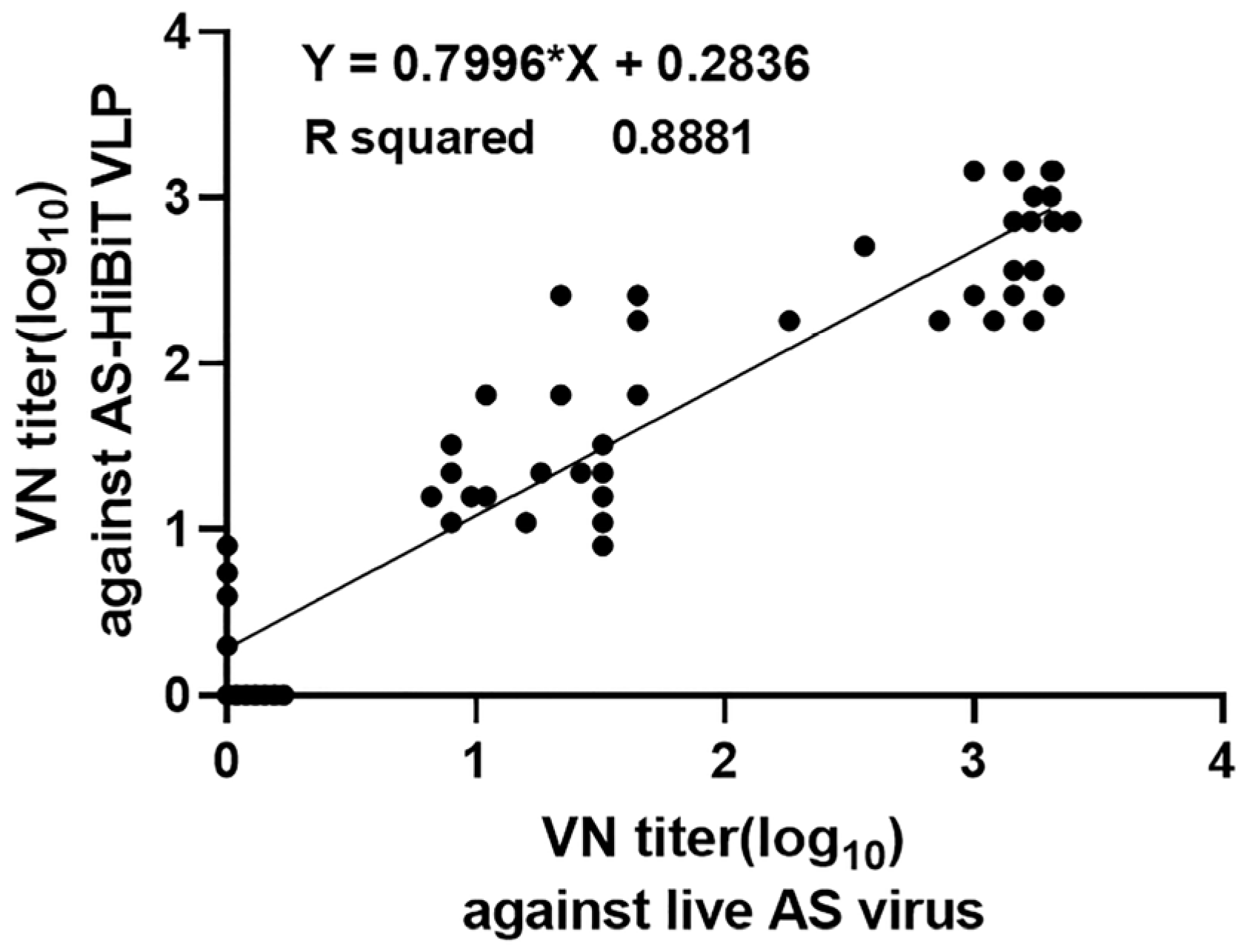Neutralizing Antibody Screening Using NanoBiT-Based Virus-like Particles of Foot-and-Mouth Disease Type Asia1 Enhances Biosafety and Sensitivity
Abstract
1. Introduction
2. Materials and Methods
2.1. Cells
2.2. Production of AS-HiBiT VLPs
2.3. Concentration and Purification of AS-HiBiT VLPs
2.4. SDS-PAGE and Western Blot Assay
2.5. Detection of AS-HiBiT VLP Entry Using a NanoBit Assay
2.6. Animal Serumdm
2.7. FMDV Asia1 Ab ELISA and Traditional Gold Standard VNT
2.8. NanoBiT-VNT Using HiBiT-AS Entry
2.9. Statistical Analysis
3. Results
3.1. Transient Expression of LgBiT and AS-HiBiT in HEK293T Cells Restored Nano-Luc Activity
3.2. Production of AS-HiBiT VLPs
3.3. Optimization of AS-HiBiT VLP Entry Conditions and Luciferase Activity in Stable LgBiT Cells
3.4. Application of NanoBiT Assay Using AS-HiBiT VLP with Guinea Pig Serum
3.5. NanoBiT-VNT Assay to Detect NAbs in Pigs
3.6. Potential Application of NanoBiT-VNT for Enhanced NAb Detection
4. Discussion
Author Contributions
Funding
Institutional Review Board Statement
Informed Consent Statement
Data Availability Statement
Conflicts of Interest
References
- Alexandersen, S.; Zhang, Z.; Donaldson, A.I.; Garland, A.J. The pathogenesis and diagnosis of foot-and-mouth disease. J. Comp. Pathol. 2003, 129, 1–36. [Google Scholar] [CrossRef] [PubMed]
- Grubman, M.J.; Baxt, B. Foot-and-mouth disease. Clin. Microbiol. Rev. 2004, 17, 465–493. [Google Scholar] [CrossRef] [PubMed]
- Liu, Z.; Shao, J.; Zhao, F.; Zhou, G.; Gao, S.; Liu, W.; Lv, J.; Li, X.; Li, Y.; Chang, H.; et al. Chemiluminescence immunoassay for the detection of antibodies against the 2C and 3ABC nonstructural proteins induced by infecting pigs with foot-and-mouth disease virus. Clin. Vaccine Immunol. 2017, 24, e00153-17. [Google Scholar] [CrossRef] [PubMed]
- Carrillo, C.; Tulman, E.R.; Delhon, G.; Lu, Z.; Carreno, A.; Vagnozzi, A.; Kutish, G.F.; Rock, D.L. Comparative genomics of foot-and-mouth disease virus. J. Virol. 2005, 79, 6487–6504. [Google Scholar] [CrossRef]
- Li, K.; Wang, C.; Yang, F.; Cao, W.; Zhu, Z.; Zheng, H. Virus–host interactions in foot-and-mouth disease virus infection. Front. Immunol. 2021, 12, 571509. [Google Scholar] [CrossRef]
- Upadhyaya, S.; Ayelet, G.; Paul, G.; King, D.P.; Paton, D.J.; Mahapatra, M. Genetic basis of antigenic variation in foot-and-mouth disease serotype A viruses from the Middle East. Vaccine 2014, 32, 631–638. [Google Scholar] [CrossRef]
- Wong, C.L.; Yong, C.Y.; Ong, H.K.; Ho, K.L.; Tan, W.S. Advances in the diagnosis of foot-and-mouth disease. Front. Vet. Sci. 2020, 7, 477. [Google Scholar] [CrossRef]
- WOAH. Chapter 3.1.8. Foot and mouth disease. In Manual of Diagnostic Tests and Vaccines for Terrestrial Animals; WOAH: Paris, France, 2024; Available online: https://www.woah.org/en/what-we-do/standards/codes-and-manuals/terrestrial-manual-online-access/ (accessed on 7 November 2024).
- WOAH. Manual of diagnostic test and vaccines of terrestrial animals: Chapter 1.1.4. In Standard for Managing Biological Risk in the Veterinary Laboratory and Animal Facilities; WOAH: Paris, France, 2024; Available online: https://www.woah.org/en/what-we-do/standards/codes-and-manuals/terrestrial-manual-online-access/ (accessed on 7 November 2024).
- Dixon, A.S.; Schwinn, M.K.; Hall, M.P.; Zimmerman, K.; Otto, P.; Lubben, T.H.; Butler, B.L.; Binkowski, B.F.; Machleidt, T.; Kirkland, T.A.; et al. NanoLuc complementation reporter optimized for accurate measurement of protein interactions in cells. ACS Chem. Biol. 2016, 11, 400–408. [Google Scholar] [CrossRef]
- Oh-Hashi, K.; Furuta, E.; Fujimura, K.; Hirata, Y. Application of a novel HiBiT peptide tag for monitoring ATF4 protein expression in Neuro2a cells. Biochem. Biophys. Rep. 2017, 12, 40–45. [Google Scholar] [CrossRef]
- Liang, X.Y.; Zhu, Q.C.; Liang, J.Q.; Liu, S.Y.; Liu, D.X.; Fung, T.S. Development of HiBiT-tagged recombinant infectious bronchitis coronavirus for efficient in vitro and in vivo viral quantification. Front. Microbiol. 2020, 11, 2100. [Google Scholar] [CrossRef]
- Nagashima, S.; Primadharsini, P.P.; Nishiyama, T.; Takahashi, M.; Murata, K.; Okamoto, H. Development of a HiBiT-tagged reporter hepatitis E virus and its utility as an antiviral drug screening platform. J. Virol. 2023, 97, e0050823. [Google Scholar] [CrossRef] [PubMed]
- Zhang, C.; Zhang, G.; Zhang, Y.; Lin, X.; Zhao, X.; Cui, Q.; Rong, L.; Du, R. Development of an HiBiT-tagged reporter H3N2 influenza A virus and its utility as an antiviral screening platform. J. Med. Virol. 2023, 95, e28345. [Google Scholar] [CrossRef]
- Cho, G.; Kim, H.; Kim, D.W.; Hwang, S.Y.; Hwang, J.H.; Chae, Y.R.; Lee, Y.H.; Jeong, O.M.; Park, J.W.; Park, S.H.; et al. Establishment of the foot-and-mouth disease virus type Asia1 expressing the HiBiT protein: A useful tool for a NanoBiT split luciferase assay. Viruses 2024, 16, 1002. [Google Scholar] [CrossRef]
- Seago, J.; Jackson, T.; Doel, C.; Fry, E.; Stuart, D.; Harmsen, M.M.; Charleston, B.; Juleff, N. Characterization of epitope-tagged foot-and-mouth disease virus. J. Gen. Virol. 2012, 93, 2371–2381. [Google Scholar] [CrossRef][Green Version]
- Guo, X.; Zhao, K.; Liu, X.; Lei, B.; Zhang, W.; Li, X.; Yuan, W. Construction and generation of a recombinant Senecavirus a stably expressing the NanoLuc luciferase for quantitative antiviral assay. Front. Microbiol. 2021, 12, 745502. [Google Scholar] [CrossRef]
- Jeremiah, S.S.; Miyakawa, K.; Ryo, A. Detecting SARS-CoV-2 neutralizing immunity: Highlighting the potential of split nanoluciferase technology. J. Mol. Cell Biol. 2022, 14, mjac023. [Google Scholar] [CrossRef]
- Meyrath, M.; Szpakowska, M.; Plesseria, J.-M.; Domingues, O.; Langlet, J.; Weber, B.; Krüger, R.; Ollert, M.; Chevigné, A.; CON-VINCE Consortium. Nanoluciferase-based cell fusion assay for rapid and high-throughput assessment of SARS-CoV-2-neutralizing antibodies in patient samples. Methods Enzymol. 2022, 675, 351–381. [Google Scholar] [CrossRef]
- Qiao, W.; Wang, S.; Zhang, C.; Huang, Z. A split NanoLuc complementation-based human norovirus-like particle entry assay facilitates evaluation of anti-norovirus antibodies in live cells. Antivir. Res. 2022, 197, 105231. [Google Scholar] [CrossRef]
- Rajan, A.; Nair, A.S.; Pillai, V.S.; Kumar, B.; Pai, A.R.; Benny, B.; Veettil, M.V. Highly sensitive and quantitative HiBiT-tagged Nipah virus-like particles: A platform for rapid antibody neutralization studies. Heliyon 2024, 10, e31905. [Google Scholar] [CrossRef]
- Wang, Y.; Ge, X.; Zhang, Y.; Guo, X.; Han, J.; Zhou, L.; Yang, H. Construction of a porcine reproductive and respiratory syndrome virus with Nanoluc luciferase reporter: A stable and highly efficient tool for viral quantification both in vitro and in vivo. Microbiol. Spectr. 2022, 10, e0027622. [Google Scholar] [CrossRef]
- Le, N.M.T.; So, K.K.; Chun, J.; Kim, D.H. Expression of virus-like particles (VLPs) of foot-and-mouth disease virus (FMDV) using Saccharomyces cerevisiae. Appl. Microbiol. Biotechnol. 2024, 108, 81. [Google Scholar] [CrossRef] [PubMed]
- Belsham, G.J.; Bøtner, A. Use of recombinant capsid proteins in the development of a vaccine against the foot-and-mouth disease virus. Virus Adapt. Treat. 2015, 7, 11–23. [Google Scholar] [CrossRef]
- Bhat, S.A.; Saravanan, P.; Hosamani, M.; Basagoudanavar, S.H.; Sreenivasa, B.P.; Tamilselvan, R.P.; Venkataramanan, R. Novel immunogenic baculovirus expressed virus-like particles of foot-and-mouth disease (FMD) virus protect guinea pigs against challenge. Res. Vet. Sci. 2013, 95, 1217–1223. [Google Scholar] [CrossRef] [PubMed]
- Cao, Y.; Lu, Z.; Sun, J.; Bai, X.; Sun, P.; Bao, H.; Chen, Y.; Guo, J.; Li, D.; Liu, X.; et al. Synthesis of empty capsid-like particles of Asia I foot-and-mouth disease virus in insect cells and their immunogenicity in guinea pigs. Vet. Microbiol. 2009, 137, 10–17. [Google Scholar] [CrossRef]
- Li, Z.; Yi, Y.; Yin, X.; Zhang, Y.; Liu, M.; Liu, H.; Li, X.; Li, Y.; Zhang, Z.; Liu, J. Development of a foot-and-mouth disease virus serotype A empty capsid subunit vaccine using silkworm (Bombyx mori) pupae. PLoS ONE 2012, 7, e43849. [Google Scholar] [CrossRef][Green Version]
- Mignaqui, A.C.; Ruiz, V.; Perret, S.; St-Laurent, G.; Singh Chahal, P.; Transfiguracion, J.; Sammarruco, A.; Gnazzo, V.; Durocher, Y.; Wigdorovitz, A. Transient gene expression in serum-free suspension-growing mammalian cells for the production of foot-and-mouth disease virus empty capsids. PLoS ONE 2013, 8, e72800. [Google Scholar] [CrossRef][Green Version]
- Veerapen, V.P.; van Zyl, A.R.; Wigdorovitz, A.; Rybicki, E.P.; Meyers, A.E. Novel expression of immunogenic foot-and-mouth disease virus-like particles in Nicotiana benthamiana. Virus Res. 2018, 244, 213–217. [Google Scholar] [CrossRef]
- Xiao, Y.; Chen, H.Y.; Wang, Y.; Yin, B.; Lv, C.; Mo, X.; Yan, H.; Xuan, Y.; Huang, Y.; Pang, W.; et al. Large-scale production of foot-and-mouth disease virus (serotype Asia1) VLP vaccine in Escherichia coli and protection potency evaluation in cattle. BMC Biotechnol. 2016, 16, 56. [Google Scholar] [CrossRef]
- Xiao, Y.; Zhang, S.; Yan, H.; Geng, X.; Wang, Y.; Xu, X.; Wang, M.; Zhang, H.; Huang, B.; Pang, W.; et al. The high immunity induced by the virus-like particles of foot-and-mouth disease virus Serotype O. Front. Vet. Sci. 2021, 8, 633706. [Google Scholar] [CrossRef]
- Zhang, J.; Ge, J.; Li, J.; Li, J.; Zhang, Y.; Shi, Y.; Sun, J.; Wang, Q.; Zhang, X.; Zhao, X. Expression of FMD virus-like particles in yeast Hansenula polymorpha and immunogenicity of combine with CpG and aluminum adjuvant. J. Vet. Sci. 2023, 24, e15. [Google Scholar] [CrossRef]
- Hwang, J.H.; Lee, K.N.; Kim, S.M.; Lee, G.; Moon, Y.; Kim, B.; Lee, J.S.; Park, J.H. Needleless intradermal vaccination for foot-and-mouth disease induced granuloma-free effective protection in pigs. J. Vet. Sci. 2019, 20, e29. [Google Scholar] [CrossRef] [PubMed]
- Kim, H.; Kim, A.Y.; Kim, J.S.; Lee, J.M.; Kwon, M.; Bae, S.; Kim, B.; Park, J.W.; Park, C.K.; Ko, Y.J. Determination of the optimal method for the concentration and purification of 146S particles for foot-and-mouth disease vaccine production. J. Virol. Methods 2019, 269, 26–29. [Google Scholar] [CrossRef] [PubMed]
- Kim, J.Y.; Park, S.Y.; Lee, G.; Park, S.H.; Jin, J.S.; Kim, D.; Park, J.H.; Jeong, S.Y.; Ko, Y.J. Determination of optimal antigen yield and virus inactivation conditions for the production of the candidate foot-and-mouth disease recombinant vaccine strain Asia1 Shamir-R in a bioreactor. Viruses 2024, 16, 457. [Google Scholar] [CrossRef]
- Kärber, G. Beitrag zur kollektiven Behandlung pharmakologischer reihenversuche. Naunyn-Schmiedebergs Arch. Pharmacol. 1931, 162, 480–483. [Google Scholar] [CrossRef]
- Spearman, C. The method of right and wrong cases (constant stimuli) without Gauss’s formulae. Br. J. Psychol. 1908, 2, 227–242. [Google Scholar] [CrossRef]
- WOAH. Foot and Mouth Disease. Available online: https://www.woah.org/en/disease/foot-and-mouth-disease/ (accessed on 7 November 2024).
- Ran, X.; Yang, Z.; Bai, M.; Zhang, Y.; Wen, X.; Guo, H.; Sun, S. Development and validation of a competitive ELISA based on bacterium-original virus-like particles of serotype O foot-and-mouth disease virus for detecting serum antibodies. Appl. Microbiol. Biotechnol. 2019, 103, 3015–3024. [Google Scholar] [CrossRef]
- Zhang, Y.; Wang, R.; Bai, M.; Wang, X.; Dong, H.; Li, J.; Mu, S.; Miao, H.; Song, J.; Sun, S.; et al. Development of a competitive ELISA method based on VLPs detecting the antibodies of serotype A FMDV. J. Virol. Methods 2022, 300, 114406. [Google Scholar] [CrossRef]
- Ausar, S.F.; Foubert, T.R.; Hudson, M.H.; Vedvick, T.S.; Middaugh, C.R. Conformational stability and disassembly of Norwalk virus-like particles. Effect of pH and temperature. J. Biol. Chem. 2006, 281, 19478–19488. [Google Scholar] [CrossRef]
- Kimura, M.; Sekiguchi, K.; Okitsu, S.; Ushijima, H.; Tani, H. A highly quantitative detection system for cell entry of human norovirus-like particles based on the complementation of NanoLuc luciferase. Virology 2022, 573, 23–28. [Google Scholar] [CrossRef]







Disclaimer/Publisher’s Note: The statements, opinions and data contained in all publications are solely those of the individual author(s) and contributor(s) and not of MDPI and/or the editor(s). MDPI and/or the editor(s) disclaim responsibility for any injury to people or property resulting from any ideas, methods, instructions or products referred to in the content. |
© 2025 by the authors. Licensee MDPI, Basel, Switzerland. This article is an open access article distributed under the terms and conditions of the Creative Commons Attribution (CC BY) license (https://creativecommons.org/licenses/by/4.0/).
Share and Cite
Kim, H.; Kim, D.-W.; Cho, G.; Hwang, J.-H.; Chae, Y.; Kim, T.; Kim, J.Y.; Ko, Y.-J.; Park, J.-H.; Lee, Y.-H.; et al. Neutralizing Antibody Screening Using NanoBiT-Based Virus-like Particles of Foot-and-Mouth Disease Type Asia1 Enhances Biosafety and Sensitivity. Viruses 2025, 17, 337. https://doi.org/10.3390/v17030337
Kim H, Kim D-W, Cho G, Hwang J-H, Chae Y, Kim T, Kim JY, Ko Y-J, Park J-H, Lee Y-H, et al. Neutralizing Antibody Screening Using NanoBiT-Based Virus-like Particles of Foot-and-Mouth Disease Type Asia1 Enhances Biosafety and Sensitivity. Viruses. 2025; 17(3):337. https://doi.org/10.3390/v17030337
Chicago/Turabian StyleKim, Hyejin, Dong-Wan Kim, Giyoun Cho, Ji-Hyeon Hwang, Yeonrae Chae, Taejun Kim, Jae Young Kim, Young-Joon Ko, Jong-Hyeon Park, Yoon-Hee Lee, and et al. 2025. "Neutralizing Antibody Screening Using NanoBiT-Based Virus-like Particles of Foot-and-Mouth Disease Type Asia1 Enhances Biosafety and Sensitivity" Viruses 17, no. 3: 337. https://doi.org/10.3390/v17030337
APA StyleKim, H., Kim, D.-W., Cho, G., Hwang, J.-H., Chae, Y., Kim, T., Kim, J. Y., Ko, Y.-J., Park, J.-H., Lee, Y.-H., & Park, S.-H. (2025). Neutralizing Antibody Screening Using NanoBiT-Based Virus-like Particles of Foot-and-Mouth Disease Type Asia1 Enhances Biosafety and Sensitivity. Viruses, 17(3), 337. https://doi.org/10.3390/v17030337





